|
|
The Four Treasures of
Chinese Painting |
|
|
|
Paper |
|
Paper is
one of the most famous Chinese inventions. It is widely accepted
that paper was invented by Cai Lun in the Eastern Han. However the
archaeologists have discovered paper of Western Han such as
"Fang-ma-tan" paper, "Ba-quao" paper, "Xuan-quan" paper, "Ma-quan-wan"
paper, "Ju-yan" paper and "Han-tan-po" paper.
After the
Eastern Jin Dynasty, paper was extensively used instead of
traditional writing materials such as bamboo slips and silks.
Various methods of producing paper emerged one after another.
In the
Tang and Song Dynasties, the paper producing industry was very
thriving. Celebrated products in best quality appeared one after
another. In the Qing "Xuan-zhi" produced in Jing Prefecture of Anhui
(Xuanzhou), became the special paper for painting and calligraphy,
and was regarded as "the king of the paper"
The
former is usually for the "Elaborate Style" of painting ; the
latter, which has a water-resistant surface, is for the "Spontaneous
Style" and allows artists to color the painting layer by layer. |
|
 |
Xuan paper-(Rice paper), 1 Ply, 2Ply
and 3ply.
size: 4',
5'and 6 feet.
Made in
China. |
|
 |
Korean
paper
Size: 28"x
56"and other size
Made in
Korea |
|
 |
Japanese
Paper ( kozo, Linen, Mulberry )
24"x35",
27'x48", and 36"x72
Made in
Japan |
|
|
|
Brush |
|
The
Brush: The brush, Mow-be in Chinese, is made from hardy materials,
including the fur of the rabbit, goat, deer and wolf. Brush handles
are made from sturdy Bamboo. Let's take a look at the structure of
the brush. On the left picture, the red part is the "core". The fur
is the longest from handle to the tip. The green part is "mantle".
The black part is the outer layer. There is a reservoir in the
brush, the white part, which lets the brush contain more ink and
water than the western brushes do.
Chinese
brushes demand great skill for proper use. The brush is very
sensitive to the slightest movement or pressure. The heavier the
pressure, the thicker the stroke; the lighter the pressure, the
thinner the stroke. With too much pressure, the brush loses its
shape, which sometimes makes special effects for paintings. In fact,
the technique requires that the artist "re-form" the tip of the
brush after nearly every stroke! In the hands of a master, the
Chinese brush produces subtle and intricate variations. |
|
Horse hair
|
Horse hair & Wolf hair |
|
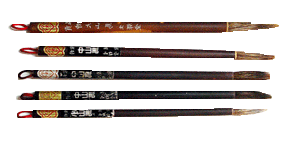 |
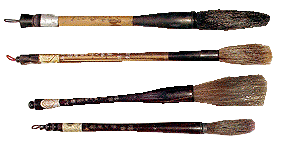 |
|
Lambs hair and Wolf hair |
|
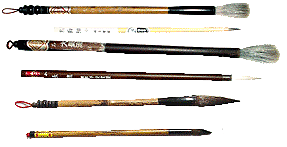
|
|
Wash brush |
|

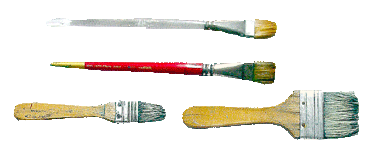 |
|
Ink |
Ink: The Ink is in stick form, made from burnt
pine wood soot, and mixed with glue. This procedure was invented
in 205 B.C. and is highly prized as the ink-maker's art. A gift of
Fine Ink Stick is a mark of high honor. Pine Wood Soot Ink (Sung
Yen Mo) is carefully ground with small amounts of water by the
artist who uses the ink stick† to produce only enough ink for the
immediate need.
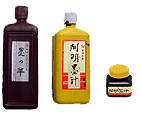
|
|
Ink Stone |
Ink
stone is the most important of "four treasures of the study".
Because of its solid texture ink stone can be handed down from
ancient times.
In the
ruins of primitive society the archaeologists discovered simple
stone ink-slab that needed a pestle to grind pigments. After
artificial ink-sticks appeared in Han, pestle gradually
disappeared. There were pottery ink-slab, lacquer ink-slab and
copper ink-slab in the Han Dynasty as well as stone ink-slab.
Among the stone ink-slabs, the round tripod pieces were the most
typical. During the Wei, Jin and Northern-and-Southern Dynasties,
round tripod porcelain ink-slabs were in vogue. It was in the Sui
and Tang that "Piyong" ink stone having circular legs appeared
The Ink
Stone: It is made of slate upon which the ink is ceremoniously
ground by the artist.
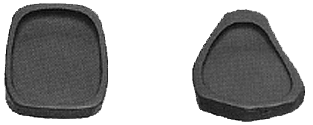
|
|
Seal – Name Chop Seal
Ink, Last Name ( White on Red ), First Name ( Red on White ) |
|
 |
|
Chinese colour: Deep red,
Brown burnt sienna), Indigo, Vermilion, Yellow cake |
|
 |
|
Mineral Colour: White
lead, Power white, Vermilion, Stone Blue, Stone Green. |
|
 |
|
Colour |
|
Acrylic
colour
Lemon
yellow, Crimson, Orange, Emerald green, light green oxide,
Cerulean
blue, Prussian blue, Cobalt blue, Burnt sienna,
White,
Cadmium red
Water
Colour
Crimson
lake, Prussian blue, Vermilion.
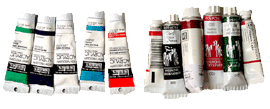 |
Poster
colour
Lemon
yellow, Orange, Emerald green. Yellow, Prussian blue,
white.
Cobalt Violet, Cerulean blue
and Chinese
painting colour set
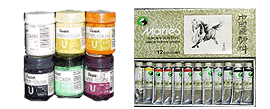
|
|
Other Painting Equipment |
1 piece wall carpet approx. 3' x 4' (Large enough to fit a full
sheet of paper on) Spray bottle. White tiles for mixing colour.
(Kitchen or bathroom type ceramic tiles approx. 6-8" long or white
china dinner plates such as corolla ware. Paper towels, cotton
rags, and newspaper. Water container.
|
|
Brush washer, Colour
container, Dishes & Tile for mixing colour Paper towel & Cloth |
|
 |
|
Alum water, Glue for
mineral colour, Spray, Mortar and Pestle (for mineral colour). |
|
 |

Questions or comments about the Gallery and the web
site are always welcome :
email
Harmony
Art Space
437
Columbia St., Vancouver BC V6A 2R9
Hours:
Tue-Sun 12 am - 5:00
pm Closed Monday
|